
The feral goat is the domestic goat (Capra aegagrus hircus) when it has become established in the wild. Feral goats occur in many parts of the world.

The feral goat is the domestic goat (Capra aegagrus hircus) when it has become established in the wild. Feral goats occur in many parts of the world.
Feral goats consist of many breeds of goats, all of which stem from the wild goat, C. aegagrus. Although breeds can look different, they all share similar characteristics. Physically, both domestic and feral goats can be identified by their prominent straight horns (more prominent on male goats), rectangular pupils, and coarse hair. In addition, most domesticated goats/feral goats lie around 100–120 pounds (45–55 kg), with heavier goats tending to be wild goats. [1]
The feral goat is seen in Australia, New Zealand, Ireland, Great Britain, Hawaii, Brazil, Honduras, Lebanon, Panama, Madagascar, Comoro Islands, Mauritius, Réunion, New Guinea, the Galapagos, Cuba and in many other parts of the world. [2] [3] When feral goats reach large populations in habitats which are not adapted to them, they may become an invasive species with serious negative effects, such as removing native scrub, trees and other vegetation. [4] [5] Feral goats are included in the 100 of the World's Worst Invasive Alien Species.
However, in other circumstances they may become a natural component of the habitat, even replacing locally extinct wild goats.
Feral goats are sometimes used for conservation grazing, to control the spread of undesirable scrub or weeds in open natural habitats such as chalk grassland and heathland.[ citation needed ]
Goats are herbivores whose diet consists of plant materials such as trees, shrubs, and grasses. Due to their stomachs, which is four-chambered, goats have the capacity to eat many plants that are typically toxic to other animals. Capeweed, for example, is toxic to most animals due to the presence of high nitrate levels. However, goats have the capacity to process these chemicals and eat capeweed with little issue. Though goats stomachs are incredibly durable, some materials still remain deadly to goats and goats will seldom eat these materials. Molds, for example, are still highly toxic for goats and have the capacity to kill a goat if consumed. Nightshades and wilted fruit trees are also toxic to goats and any presence of Listeria bacteria can prove fatal to goats as they are incredibly susceptible to the bacteria. Outside of plant materials, goats have also been seen attempting to eat nearly any object that they're curious about as well. Notably, goats have been seen eating litter such as tin cans and cardboard and although their stomachs can process the material, they get no nutritional value from it and should still be eating plant materials. [6]
Having a wide habitat range, goats also have a wide array of predators. Canine species are particularly impactful predators of the goat. These include coyotes, wolves, and foxes. In addition to these species, other animals such as bobcats and birds of prey, such as eagles, have been noted to hunt and eat feral goats. [6]
Majorca or Mallorca is an island in the Balearic Islands, which are a part of Spain and located in the Mediterranean Sea. These feral goats, also known as Balearen bocs, were introduced by humans between 2300 and 2050 BC. They were originally used as a food source but eventually they began being a threat to domesticated goats and native tree species. The biggest threat to their conservation is hybridization with current domestic goats, but both are the same subspecies (Capra aegagrus hircus). These populations threaten the growth of new trees in several forests on the island, specially oak forests. [7]
Around 5000 BP non-native goats also known as British primitive goats were brought to Britain as domestic stock, bred for milk and meat. Today, the goat species Capra hircus are still present in the country with a total population of 5,000–10,000 individuals. The number of goats are constantly changing due to management, conservation, reproduction and removal. [8] This invasive goat species is destructive to the natural habitat and therefore means of removal are available. One way these goats are managed is through hunting. In England they do not have a closed season for goat hunting, and are able to be hunted year round.[ citation needed ]
Feral goats were brought to Ireland over 4000 years ago for their meat, milk, and hair. They are typically found in mountainous regions of Ireland and have no known predators, not even humans. [9] Feral goats are common in many areas of the Irish west coast including counties Mayo, Donegal and Kerry. There are about 5,000 goats in Ireland, and though they are not formally protected, they are often ignored by humans and not typically hunted. They are destructive when it comes to native species because they mainly eat grass, shrubs and young trees, but as of now there is no plan to eradicate them from the country. [10]
Three goat species have been known to exist within New Zealand, namely the Arapawa goat, the Auckland Island goat and the New Zealand goat. Out of the three, the Arapawa goat's populations are too small for it to be any threat at all to the Arapaoa Island that it resides on, with them today being noted to be critically endangered.[ citation needed ]
The Auckland Island goat was introduced in the 19th century to serve as a food source for castaways on the Auckland Island. Although about 100 goats were observed to have lived on the island at the time, this population managed to do considerable damage to the island's ecosystem. As a result, the goat population was located and dealt with accordingly. About 60 goats were exported off the island for domestication in 1992 and the remaining population was killed off. As of 1999, the Auckland Island goat has been considered extinct.[ citation needed ]
The last species, the New Zealand feral goats, were brought onto the North and South Islands in 1773 by early explorers, whalers, sealers and settlers who brought goats with them for food and bartering. Over time, more goats were brought in for a variety of purposes, from livestock to the handling of other invasive plant species. This problem culminated in 14% of New Zealand now being populated by feral goats, all of which have begun to destroy the natural florae of the islands. Currently, hunting and training Judas goats are the primary means of handling the threat but this has not done much to stop the goats and they still remain a threat. [11]
The feral goats of Scotland were brought in by Neolithic-era humans for farming purposes but were likely abandoned around the late 1700s due to the Highland Clearances, the evictions of a significant number of tenants in the Scottish Highlands and Islands. These people were unable to bring their livestock with them and, instead, had to leave them to roam the Highlands. The goats from this collective of livestock were able to get a foothold in this environment however and within little time, the population of Highland goats exploded to about 3,000 to 4,000. Though they are very common to see, they are also heavily considered both a nonnative, invasive species by the Scottish government as well as a major threat to the Scottish Highlands with there being evidence of the goats contributing to grazing pressures on at least 18 different conservational sites. [12] Hunting remains as one of the primary ways that the population is handled and though a few population management plans have been discussed, few have gotten off of the ground. [13]
One of the most acute United States feral goat issues arose on San Clemente Island off the coast of southern California. The goats were first introduced onto the island as of 1875 from another nearby island, Santa Catalina Island, and had not been properly managed since, allowing their population to spike up to about 15,000. This population had begun to damage the natural ecosystem of the island, destroying crops and other plant life as well as interfering with the animals that had used said plants as a food source. The United States Navy, being the owners of the island as of 1934, allowed hunting and trapping of these goats until 1972 when it was determined that this had not made a dent in the goat population. An official culling program had to be organized to properly exterminate the goats.
Fund for Animals, a non-government organization for ethical animal treatment suggested auctioning the goats to U.S. citizens on the mainland. This plan eliminated 3,000 goats from the island just by moving them to mainland farms to be domesticated once more, and many of the goats that had not been bought were adopted by the Fund for Animals agency instead to protect them. Any remaining goats were permitted to be shot by the United States Navy and as of 1991, the island has been declared free of its feral goat issue. [14] The Livestock Conservancy considers them a critically endangered heritage breed. In 2008, their global population was approximately 400, all domesticated. The goats’ bleat is so consistent that it is sometimes confused with a recorded goat sound.[ citation needed ]
Feral goats occur in the Welsh mountains for example the Rhinogydd range in Snowdonia. They are used for conservation grazing in a number of places, such as at Stackpole in South Wales or on Great Orme in Llandudno in North Wales.[ citation needed ]
Feral goats in any country cause many long-term problems pertaining to the native vegetation. These problems are caused by overgrazing of these species, as well as the erosion of soil due to the loss of plant roots. These goats also affect native animal species because they are using a multitude of resources, causing an increased amount of competition. Lastly, they can affect the ecosystem by spreading plants and weeds into areas they aren't typically seen in through their excrement. [6] This eventually causes damage because native species of plants now have competition. Besides environmental damage, they also cause damage to the economy by damaging agriculture and causing the government to spend to control them. [15]
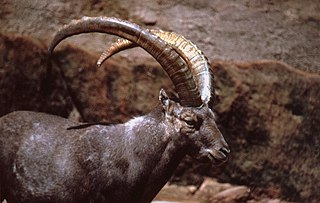
An ibex is any of several species of wild goat , distinguished by the male's large recurved horns, which are transversely ridged in front. Ibex are found in Eurasia, North Africa and East Africa.
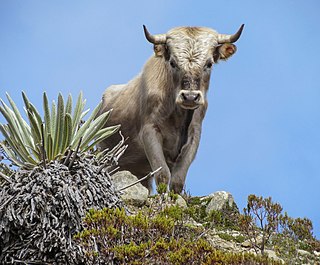
A feral animal or plant is one that lives in the wild but is descended from domesticated individuals. As with an introduced species, the introduction of feral animals or plants to non-native regions may disrupt ecosystems and has, in some cases, contributed to extinction of indigenous species. The removal of feral species is a major focus of island restoration.

A feral pig is a domestic pig which has gone feral, meaning it lives in the wild. The term feral pig has also been applied to wild boars, which can interbreed with domestic pigs. They are found mostly in the Americas and Australia. Razorback and wild hog are Americanisms applied to feral pigs or boar–pig hybrids.

Capra is a genus of mammals, the goats, comprising ten species, including the markhor and several species known as ibexes. The domestic goat is a domesticated species derived from the bezoar ibex. Evidence of goat domestication dates back more than 8,500 years.
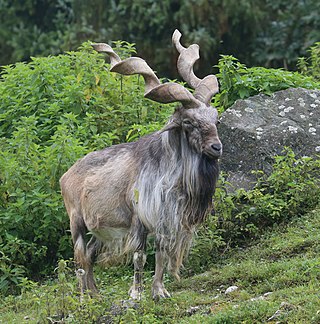
The markhor is a large wild Capra (goat) species native to South Asia and Central Asia, mainly within Pakistan, India, the Karakoram range, parts of Afghanistan, and the Himalayas. It is listed on the IUCN Red List as Near Threatened since 2015.
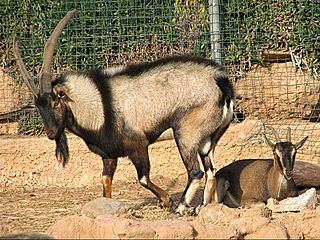
The Kri-Kri, sometimes called the Cretan goat, Agrimi, or Cretan Ibex, is a feral goat inhabiting the Eastern Mediterranean, previously considered a subspecies of wild goat. The Kri-Kri today is found only in Greece: specifically on Crete and on three small islands off its coast ; as well as on the island of Sapientza off the southwestern coast of Peloponnese, where it was brought in great numbers in order to protect the species from extinction.

The wild goat is a wild goat species, inhabiting forests, shrublands and rocky areas ranging from Turkey and the Caucasus in the west to Turkmenistan, Afghanistan and Pakistan in the east. It has been listed as near threatened on the IUCN Red List and is threatened by destruction and degradation of habitat.

The ecological restoration of islands, or island restoration, is the application of the principles of ecological restoration to islands and island groups. Islands, due to their isolation, are home to many of the world's endemic species, as well as important breeding grounds for seabirds and some marine mammals. Their ecosystems are also very vulnerable to human disturbance and particularly to introduced species, due to their small size. Island groups, such as New Zealand and Hawaii, have undergone substantial extinctions and losses of habitat. Since the 1950s several organisations and government agencies around the world have worked to restore islands to their original states; New Zealand has used them to hold natural populations of species that would otherwise be unable to survive in the wild. The principal components of island restoration are the removal of introduced species and the reintroduction of native species.

The Nubian ibex is a desert-dwelling goat species found in mountainous areas of northern and northeast Africa, and the Middle East. It was historically considered to be a subspecies of the Alpine ibex, but is now considered a distinct species. The wild population is estimated at 4,500 mature individuals, and it is classified as vulnerable.

A feral horse is a free-roaming horse of domesticated stock. As such, a feral horse is not a wild animal in the sense of an animal without domesticated ancestors. However, some populations of feral horses are managed as wildlife, and these horses often are popularly called "wild" horses. Feral horses are descended from domestic horses that strayed, escaped, or were deliberately released into the wild and remained to survive and reproduce there. Away from humans, over time, these animals' patterns of behavior revert to behavior more closely resembling that of wild horses. Some horses that live in a feral state but may be occasionally handled or managed by humans, particularly if privately owned, are referred to as "semi-feral".

The walia ibex is a vulnerable species of ibex. It is sometimes considered an endemic subspecies of the Alpine ibex. If the population were to increase, the surrounding mountain habitat would be sufficient to sustain only 2,000 ibex. The adult walia ibex's only known wild predator is the hyena. However, young ibex are often hunted by a variety of fox and cat species. The ibex are members of the goat family, and the walia ibex is the southernmost of today's ibexes. In the late 1990s, the walia ibex went from endangered to critically endangered due to the declining population. The walia ibex is also known as the Abyssinian ibex. Given the small distribution range of the Walia ibex in its restricted mountain ecosystem, the presence of a large number of domestic goats may pose a serious threat that can directly affect the survival of the population.

Conservation grazing or targeted grazing is the use of semi-feral or domesticated grazing livestock to maintain and increase the biodiversity of natural or semi-natural grasslands, heathlands, wood pasture, wetlands and many other habitats. Conservation grazing is generally less intensive than practices such as prescribed burning, but still needs to be managed to ensure that overgrazing does not occur. The practice has proven to be beneficial in moderation in restoring and maintaining grassland and heathland ecosystems. Conservation or monitored grazing has been implemented into regenerative agriculture programs to restore soil and overall ecosystem health of current working landscapes. The optimal level of grazing and grazing animal will depend on the goal of conservation. Different levels of grazing, alongside other conservation practices, can be used to induce desired results.
Buckaringa Sanctuary is a 20 km2 nature reserve in the southern Flinders Ranges of South Australia. It is 30 km north of the town of Quorn. It is owned and managed by the Australian Wildlife Conservancy (AWC).

The bezoar ibex is a wild goat subspecies that is native to the montane forested areas in the Caucasus and the Zagros Mountains.

The goat or domestic goat is a species of domesticated goat-antelope that is mostly kept as livestock. It was domesticated from the bezoar ibex of Southwest Asia and Eastern Europe. The goat is a member of the family Bovidae, meaning it is closely related to the sheep. There are over 300 distinct breeds of goat. It is one of the oldest domesticated species of animal - according to archaeological evidence its earliest domestication occurred in Iran at 10,000 calibrated calendar years ago.

Feral goats are an invasive animal species in Australia. First arriving in the 18th century with European settlers, feral goat populations originated from escaped domestic individuals. Today, feral goats are found across Australia, where they cause economic and environmental damage through overgrazing and competition with livestock and native marsupials.

Palila v. Hawaii Department of Land and Natural Resources was an ecological court case pertaining to the Palila and the Māmane-Naio ecosystem of Mauna Kea. The case stems from the introduction of goats and sheep onto Hawaiʻi island in the late 18th century, which became feral and damaged the local ecosystem. Before the 1920s elimination program was completed, it was replaced with a game control plan that caused controversy between hunters and conservationists. Claiming that the state of Hawaii was violating the Endangered Species Act, a suit was filed to the Ninth District Court; as a result, the state was ordered to eradicate all feral animals on the island within two years. A public hunting program was put in place and has been largely effective; the Palila has begun to recover, and the case demonstrated federal power to protect endangered species.

Seabirds include some of the most threatened taxa anywhere in the world. For example, of extant albatross species, 82% are listed as threatened, endangered, or critically endangered by the International Union for Conservation of Nature. The two leading threats to seabirds are accidental bycatch by commercial fishing operations and introduced mammals on their breeding islands. Mammals are typically brought to remote islands by humans either accidentally as stowaways on ships, or deliberately for hunting, ranching, or biological control of previously introduced species. Introduced mammals have a multitude of negative effects on seabirds including direct and indirect effects. Direct effects include predation and disruption of breeding activities, and indirect effects include habitat transformation due to overgrazing and major shifts in nutrient cycling due to a halting of nutrient subsidies from seabird excrement. There are other invasive species on islands that wreak havoc on native bird populations, but mammals are by far the most commonly introduced species to islands and the most detrimental to breeding seabirds. Despite efforts to remove introduced mammals from these remote islands, invasive mammals are still present on roughly 80% of islands worldwide.
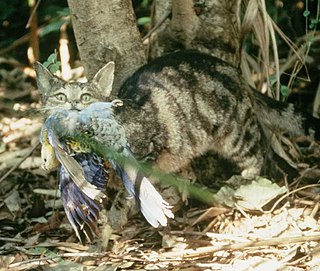
Cat predation on wildlife is the result of the natural instincts and behavior of both feral and owned house cats to hunt small prey, including wildlife. Some people view this as a desirable phenomenon, such as in the case of barn cats and other cats kept for the intended purpose of pest control in rural settings; but scientific evidence does not support the popular use of cats to control urban rat populations, and ecologists oppose their use for this purpose because of the disproportionate harm they do to native wildlife. As an invasive species and predator, they do considerable ecological damage.

The Gau iguana is a species of iguana endemic to Gau Island in the Fijian archipelago. It mostly lives in the well-preserved upland forests of the island, with smaller populations in the degraded coastal forests. It can be distinguished from other South Pacific iguanas by the male's distinctive color pattern and solid green throat. It is also the smallest of all South Pacific iguanas, being about 13% smaller than the third smallest species and 40% smaller than the largest extant species.